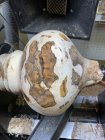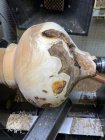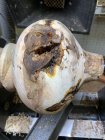looks like fun- regardless of what you find
I would first try to get a sense of the structural integrity.
Identify Major bark inclusions, punky wood if any.
if that is a hole in the center I would probe around inside it with a screw driver. May be better suited for two small hollow forms than one large one.
if it is all punky maybe it becomes a bunch of ornament balls using one of the stabilization techniques.
I have used a lot of burls with the wood part mounted to a face plate. This gets solid wood as the mounting point and the pretty burl on the top to show itself off.
My first thought would be am 11-12” diameter hollow form.
Assuming what I can learn about the integrity supports the idea,
I would decide where the opening an center of the HF would be and the rip the log section close to the pith so that I can cut the blank round on the bandsaw.
Then drill a shallow 1” hole for the opening to solid wood on the drill press put a spur drive in the opening then rough turn it between centers and turn a mounting place for a faceplate.
the rough turning will teach me a lot about the structure of the burl and allow me to reposting the tail center to get more burl surface or position the opening of a void.
never quite sure what you get when turning a burl like that.





